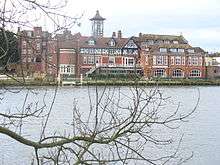Henry Edward Kendall Jr.
| Henry Edward Kendall | |
|---|---|
| Born | 1805 |
| Died |
June 9, 1885 (aged 79–80) Paddington |
| Occupation | Architect |
| Parent(s) | Henry Edward Kendall |
| Buildings | Knebworth House, Pope's Villa, Shuckburgh Hall, Kilmorey Mausoleum |


Henry Edward Kendall Junior (1805–9 June 1885) was a British architect.
Background
Kendall was the son of Henry Edward Kendall, also an architect.[1] Both were among the co-founders of what became the Royal Institute of British Architects.[2]
Early career
The two initially shared a practice, which in 1834 was located at 17 Suffolk Street, London. The Esplanade and Tunnel in Kemp Town, Brighton, dating between 1828 and 1830, was one of their notable works.[3] Lewis Cubitt was amongst those who worked at the practice before setting up on his own.[4]
Many works
Kendall's works included schools, a few churches including the round-arched church of St John, Harrow Road, Kensal Green (1844), parsonages, three lunatic asylums and many houses including the remodelling of Knebworth House (1843), Shuckburgh Hall (1844), 'Pope's Villa', Twickenham (built c. 1845 on the site of Alexander Pope's house, which had been demolished in 1808/09),[5][6] and a house in Farnborough, Hampshire, built in 1860 for publisher Thomas Longman, subsequently home of Empress Eugénie of France and, since 1927, home to Farnborough Hill Girls School.[7] He also designed the mausoleum of the 2nd Earl of Kilmorey and his mistress, built in Brompton Cemetery, London, in 1854, then relocated to Woburn Park, Chertsey in 1862, and moved to Isleworth in 1870.[3] He was District Surveyor for Hampstead from 1844 and produced a book on school designs.[2] Towards the end of his career, he established a practice with his nephew, Frederick Mew.[2]
Paintings
Kendall exhibited paintings of architectural subjects at the Royal Academy between 1799 and 1843.[8]
Death
He died in 1885 in Paddington, aged 79.[9]
References
- ↑ "Henry Edward Kendall (1776–1875) architect". Oxford Dictionary of National Biography. Retrieved 21 May 2015 – via Oxford Index.
- 1 2 3 "Sussex Parish Churches - Architects and Artists I-J-K". Retrieved 25 May 2015. citing obituary in:"Henry Edward Kendall Jr". The Builder. 48: 883–884.
- 1 2 "Henry Edward Kendall". Dictionary of Scottish Architects. Retrieved 22 May 2015.
- ↑ "Overview: Lewis Cubitt". Retrieved 21 May 2015.
- ↑ "George Buckingham, Organ builder, b1806". The Twickenham Museum. Retrieved 31 October 2015.
- ↑ Winterman, Denise (7 March 2013). "The man who demolished Shakespeare's house". BBC News. Retrieved 22 May 2015.
- ↑ Historic England. "Main Building to Farnborough Hill Convent (Grade I) (1303116)". National Heritage List for England. Retrieved 25 May 2015.
- ↑ Wood, Christopher (2008). Victorian Painters: Text. Dictionary of British Art. 4 (4th ed.). Woodbridge: Antique Collectors' Club. ISBN 9781851491711.
- ↑ "Index entry". FreeBMD. ONS. Retrieved 25 May 2015.
External links
-
 Media related to Henry Edward Kendall Jr. at Wikimedia Commons
Media related to Henry Edward Kendall Jr. at Wikimedia Commons - Kendall's funerary sculpture, Kensal Green Cemetery